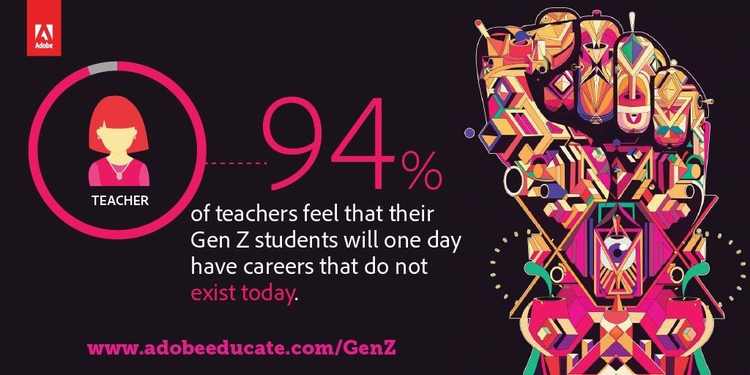Gen Z in the Classroom: Creating the Future


http://blogs.adobe.com/conversations/files/2016/10/Gen-z1.jpg
They’re constantly on phones and devices. They text instead of calling. They tweet. They snap. They design their own apps. Technology is their native environment.
Generation Z (11-17 year olds) is growing up in a world that looks completely different from the one their parents and teachers grew up in. To learn more about Gen Z, we launched a study of over 1,000 students in the U.S. and 400+ of their teachers to find out how this generation thinks about creativity, technology and their futures beyond the classroom. The findings give us insights into how teachers can nurture Gen Z’s creativity, and prepare them for the challenges ahead.
Teaching for a Gen Z worldview
The first thing that struck me about our findings was that teachers and students agreed on quite a lot—not something you always expect at this age! When we asked what Gen Z’s future will look like, teachers (91 percent) and students (85 percent) agreed overwhelmingly that creativity will be essential to their success. And both groups felt that understanding technology is key to preparing students for their futures. They also agreed that Gen Z learns best through doing—creating things, experiencing the world hands-on and connecting their classroom experience to the larger world around them.
So how do educators put these insights into practice? One key is to give students projects with more than one possible outcome, or lots of approaches to finding a solution. This helps encourage creativity while developing the kind of thinking that builds science and tech skills—and it’s something that’s catching on in classrooms everywhere. For example, a wonderful trend in math right now is to ask students to solve a problem in more than one way, helping them build flexibility into their thinking. In history, teachers are asking students to use primary sources to investigate mysteries that historians themselves don’t agree on, building students’ ability to draw conclusions and make their own arguments to support their thinking. And the citizen-scientist movement has students adding their research to real scientific studies about topics like climate change and the human genome. In all of these cases, students flex their creative muscles in real-world applications with relevance beyond their classrooms.
Creativity in their careers
When we asked students which classes required creativity, which prepared them for the future and which were their favorites, the top answers aligned. In every category, computers and technology or science and engineering were among the first two on the list. As adults, we often think of technology as a means to an end but for Gen Z, it’s a key to creativity and self-expression. And this makes sense—they are growing up immersed in digital modes of communication. As Gen Z moves on beyond education, either to college or into the workforce, they’ll need to use technology to express themselves creatively—it’s a tool, but it’s also a central mode for expression and problem solving.
So how do we help students build skills so they don’t just consume the creative content coming at them, but also develop their own voices? We can encourage them to design unique apps, create presentations about their research or build online portfolios of their work. At Chute Middle School outside of Chicago, for example, students created powerful media and performance pieces with digital images and words to communicate their complex identities and overcome stereotypes.
It can be a challenge to manage lessons like the one at Chute—teachers need technology that can unlock student’s creativity, without overwhelming the content of the lesson. One great and free entry point is Adobe Spark. Designed to help anyone, including students, share ideas visually and digitally, Spark is easy to use. Students can create beautiful work while keeping the focus on what they want to communicate.
Teaching for an unknown future
The students in our study told us that they are excited and nervous about the future. And it’s no wonder they feel this way—94 percent of their teachers believe Gen Z will work in careers that haven’t even been imagined yet. We can’t prepare them for the exact work they’ll do, but we can teach them to be life-long learners, to be creators, to solve problems and express themselves using whatever tools are available. Imagine a young person coming to a job interview with an app she built in class. When she shows it to a potential employer, she’s demonstrating a specific technology skill, but she’s also showing her ability to communicate and solve a problem in a creative way. These are the skills employers tell us they need. Wherever Gen Z goes, these skills will help take them there.
Get all the details about the methodology and findings of our study, “Generation Z in the Classroom: Creating the Future” and read more on our blog about Adobe’s work to bring creative technology into the classroom.
To learn more about teaching digital literacy, teachers can check out Adobe Education Exchange—a community of 330,000 educators sharing what works in their classrooms, exploring more than 12,000 free learning resource and participating in free professional development.